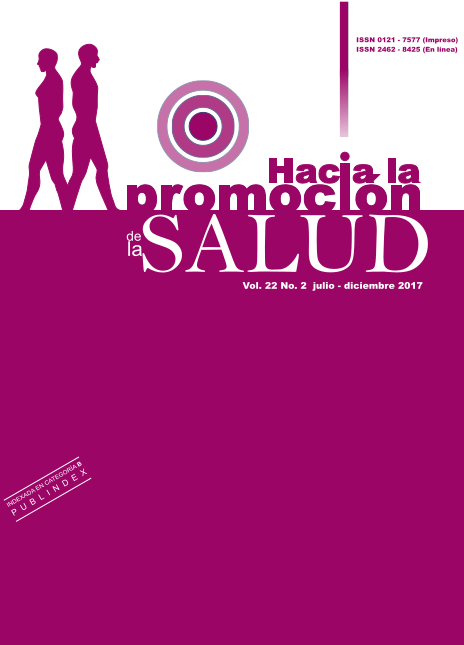Authors
Abstract
Objective: To describe the behavior and health system response to gender violence in the department of Meta, Colombia. Materials and Methods: An observational cross-sectional study was designed with the reported sexual and gender violence in the department during 2015. Results: A total of 1,569 cases were studied. The average age was 20.7 years, most of them were women, 81.7%, 59.44% from lowincome status; they were housewives, 36.9% or students 20.72%. The most frequent offender was a young man (14-45 years) 67.18%, who had an affective relationship with the victim and cohabited with her. The highest occurrence patterns were physical violence 46.4%, abandonment-neglect 25.18%, and sexual abuse 24.16%. The most common aggressor mechanism was the short blunt weapon, 52.35%, and the most affected anatomical areas are the face, the neck and the hands, 36.3%. The most frequent place of aggression was the house, 73.4% and public places. Vulnerable population affected was evidenced including pregnant women and victims of armed violence. The health system operates in comprehensive care effectively but is limited to the attention of physical damage and does not active the attention route established, thus generating greater risks to the victim. Conclusions: A high incidence of gender violence was found being the risk factors: being a female, student or housewife, cohabitating, low income and low educational level. The health system must be involved in the comprehensive care of the event.
References
2. Foucault M. Estrategias de poder. Buenos Aires: Ediciones Paidós Ibérica S. A. 1999.
3. Ruiz-Pérez I, Blanco-Prieto P, Vives-Cases C. Violencia contra la mujer en la pareja: determinantes y respuestas sociosanitarias. Gaceta Sanitaria. 2004; 18 (Supl. 2), 4-12. [Acceso 23 de mayo de 2017]. Disponible en: Disponible en: http://scielo.isciii.es/scielo.php?script=sci_arttext&pid=S0213-91112004000500003&lng=es&tlng=es.
4. Organización Mundial de la Salud. Estudio multipaís de la OMS sobre salud de la mujer y la violencia doméstica. Ginebra Suiza; 2005. [Internet] [Acceso 9 de agosto 2016]. Disponible en: Disponible en: http://apps.who.int/iris/bitstream/10665/43390/1/924359351X_spa.pdf
5. Bourdieu P. La dominación masculina. Barcelona: Editorial Anagrama. 2002.
6. Organización Mundial de la Salud OMS. Estimaciones mundiales y regionales de la violencia contra la Mujer. Ginebra Suiza; 2013 [Internet]; [Acceso 8 de agosto 2016]. Disponible en: Disponible en: http://www.who.int/reproductivehealth/publications/violence/9789241564625/es/
7. Guedes A, Mikton Ch. Examining the Intersections between Child Maltreatment and Intimate Partner Violence. West J Emerg Med. 2013; 14(4): 377-379.
8. Instituto Nacional de Salud INS. Boletín Epidemiológico Semanal. Bogotá; 2015 [Internet]. [Acceso 8 de agosto de 2016]. Disponible en: Disponible en: http://www.ins.gov.co/boletin-epidemiologico/Boletn%20Epidemiolgico/2015%20Boletin%20epidemiologico%20Semana%2052.pdf.
9. Kazaura et al. Magnitude and factors associated with intimate partner violence in mainland Tanzania. BMC Public Health, 2016: 16: 494.
10. García M, Matud M. Salud mental en mujeres maltratadas por su pareja. México y España. Salud Mental 2015, 321-327.
11. Guita G, Debert SB. La violencia de género y la administración de la justicia en Brasil: el caso de São Paulo. Journal of Feminist, Gender and Women Studies. 2015, 2:1.
12. Moreno-Cubillos C, Osorio-Gómez L. Violencia sexual contra las estudiantes de la Universidad de Caldas (Colombia): estudio de corte transversal. Revista Colombiana de Obstetricia y Ginecología; 2016. 58(2), 116-123. [Acceso 9 de agosto de 2016], Disponible en: Disponible en: http://www.scielo.org.co/scielo.php?script=sci_arttext&pid=S003474342007000200004&lng=en&tlng=es.
13. MacMillan HL, Wathen C, Jamieson E. Screening for intimate partner violence in health care settings: a randomized trial. JAMA, 2009, 302(5):493-501.
14. Bair-Merritt MH, Jennings J et al. Reducing maternal intimate partner violence after the birth of a child: a randomized controlled trial of the Hawaii Healthy Start Home Visitation Program. Arch Pediatr Adolesc Med. 2010, 164(1):16-23.
15. Coll-Vinent B, Echeverría T, Farràs Ú, Rodríguez D, Millá J, Santiñà M. El personal sanitario no percibe la violencia doméstica como un problema de salud. Gac Sanit; 2008. 22 (1): 7-10 [Internet]. Disponible en: http://scielo.isciii.es/scielo.php?script=sci_arttext&pid=S0213-91112008001100002&lng=es.
16. Pérez Martínez VT, Hernández-Marín Y. La violencia psicológica de género, una forma encubierta de agresión. Rev Cubana Med Gen Integr; 2009; 25 (2) [Internet]. Disponible en: http://scielo.sld.cu/scielo.php?script=sci_arttext&pid=S0864-21252009000200010&lng=es.
17. López-Angulo LR. Aproximación al estudio de la violencia en la relación de pareja en mujeres con infecciones de transmisión sexual. Revista Cubana de Medicina General, 2015; 31(4) [Acceso 9 de agosto de 2016]. Disponible en: Disponible en: http://scielo.sld.cu/scielo.php?script=sci_arttext&pid=S0864-21252015000400004&lng=es&tlng=es.
18. Palomino A, Saravia JC, Becerra S, Mejía M. Violencia física contra la mujer durante el embarazo: prevalencia y factores asociados. Revista Peruana de Epidemiología, 2012, 84-90.
19. Fátima A. Meta-análisis de las investigaciones sobre violencia de género: el estado produciendo conocimiento. Atenea Digital, 2015 15(1), 171-203. [Acceso 23 mayo 2017]. Disponible en: Disponible en: http://dx.doi.org/10.5565/rev/athenea.1394.
20. Organización Mundial de la Salud OMS. Informe sobre la situación mundial de la prevención de la violencia 2014. Ginebra Suiza. [Internet]. [Acceso 23 de mayo 2017] Disponible Disponible http://apps.who.int/iris/bitstream/10665/145089/1/WHO_NMH_NVI_14.2_spa.pdf?ua=1.


 PDF (Español)
PDF (Español)
 FLIP
FLIP


























